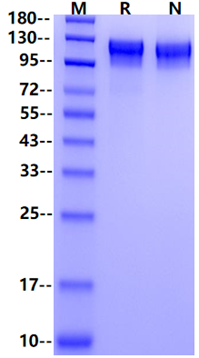Met22-Arg734, with C-terminal 10*His MAFAPIPRITWEHREVHLVQFHEPDIYNYSALLLSEDKDTLYIGAREAVFAVNALNISEKQHEVYWKVSEDKKAKCAEKGKSKQTECLNYIRVLQPLSATSLYVCGTNAFQPACDHLNLTSFKFLGKNEDGKGRCPFDPAHSYTSVMVDGELYSGTSYNFLGSEPIISRNSSHSPLRTEYAIPWLNEPSFVFADVIRKSPDSPDGEDDRVYFFFTEVSVEYEFVFRVLIPRIARVCKGDQGGLRTLQKKWTSFLKARLICSRPDSGLVFNVLRDVFVLRSPGLKVPVFYALFTPQLNNVGLSAVCAYNLSTAEEVFSHGKYMQSTTVEQSHTKWVRYNGPVPKPRPGACIDSEARAANYTSSLNLPDKTLQFVKDHPLMDDSVTPIDNRPRLIKKDVNYTQIVVDRTQALDGTVYDVMFVSTDRGALHKAISLEHAVHIIEETQLFQDFEPVQTLLLSSKKGNRFVYAGSNSGVVQAPLAFCGKHGTCEDCVLARDPYCAWSPPTATCVALHQTESPSRGLIQEMSGDASVCPDKSKGSYRQHFFKHGGTAELKCSQKSNLARVFWKFQNGVLKAESPKYGLMGRKNLLIFNLSEGDSGVYQCLSEERVKNKTVFQVVAKHVLEVKVVPKPVVAPTLSVVQTEGSRIATKVLVASTQGSSPPTPAVQATSSGAITLPPKPAPTGTSCEPKIVINTVPQLHSEKTMYLKSSDNRGGGSGGGSHHHHHHHHHH
95-130kDa
PBS, pH7.4
Reconstitute at 0.1-1 mg/ml according to the size in ultrapure water after rapid centrifugation.
· 12 months from date of receipt, lyophilized powder stored at -20 to -80℃.
· 3 months, -20 to -80℃ under sterile conditions after reconstitution.
· 1 week, 2 to 8℃ under sterile conditions after reconstitution.
· Please avoid repeated freeze-thaw cycles.
1. Biochem Soc Trans . 2020 Dec 18;48(6):2875-2890.
Semaphorin 4D is a 150 kDa type I transmembrane glycoprotein that belongs to the Class 4 family of transmembrane immune and nervous system semaphorins. Semaphorin 4D, also known as CD100, is an important member of the semaphorin family and was first characterized as a lymphocyte-specific marker. Semaphorins play crucial roles in regulating multiple biological processes, such as neural remodeling, tissue regeneration, cancer progression, and, especially, in immunological regulation. Sema4D, produced by T cells, activated B cells and dendritic cells acts through a low affinity receptor termed CD72 in the immune system.In cancer, Sema4D can also be produced by tumor-associated macrophages, and bind to endothelial cell Plexin B1, thus promoting tumor angiogenesis.

2μg (R: reducing condition, N: non-reducing condition).